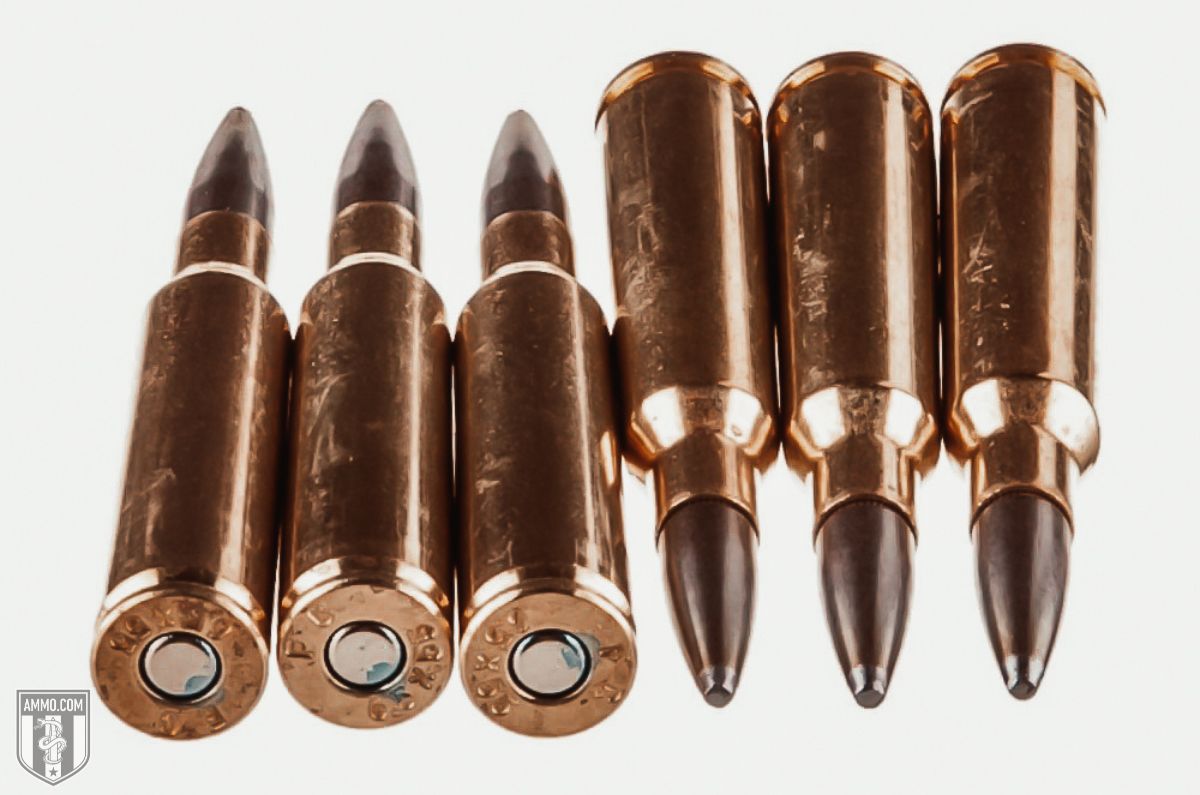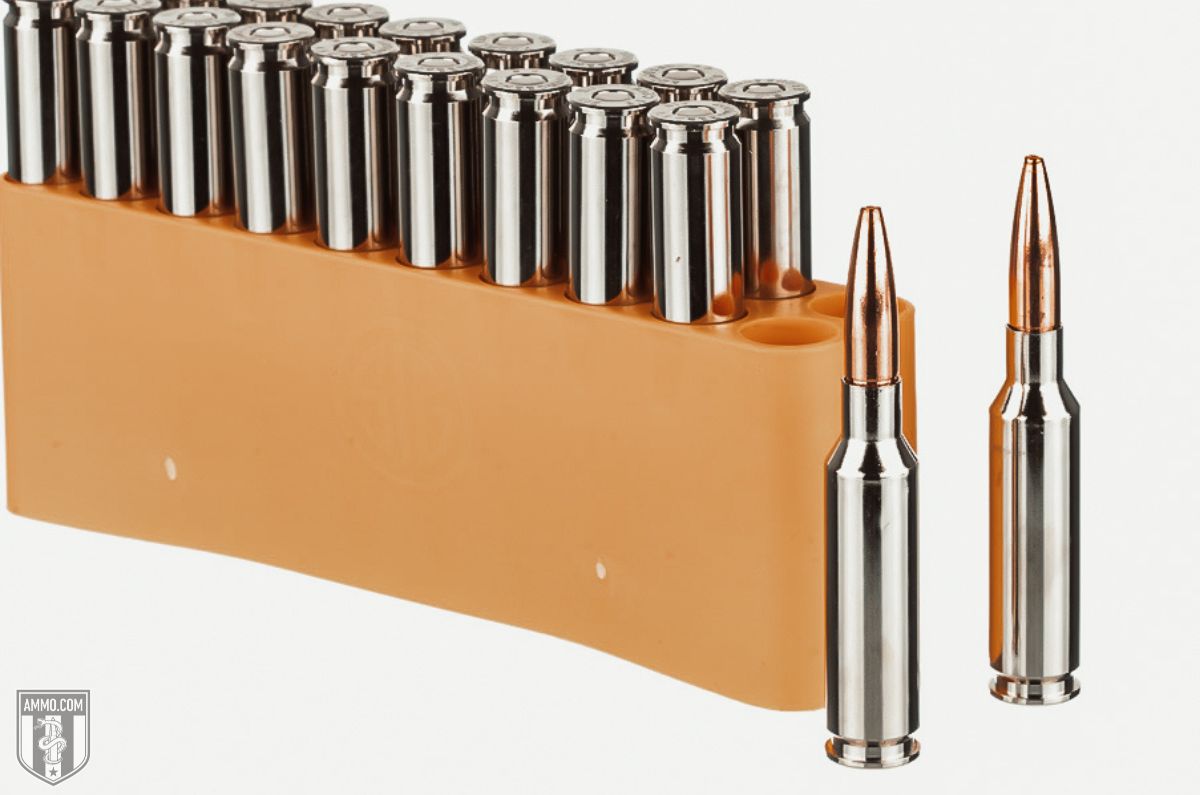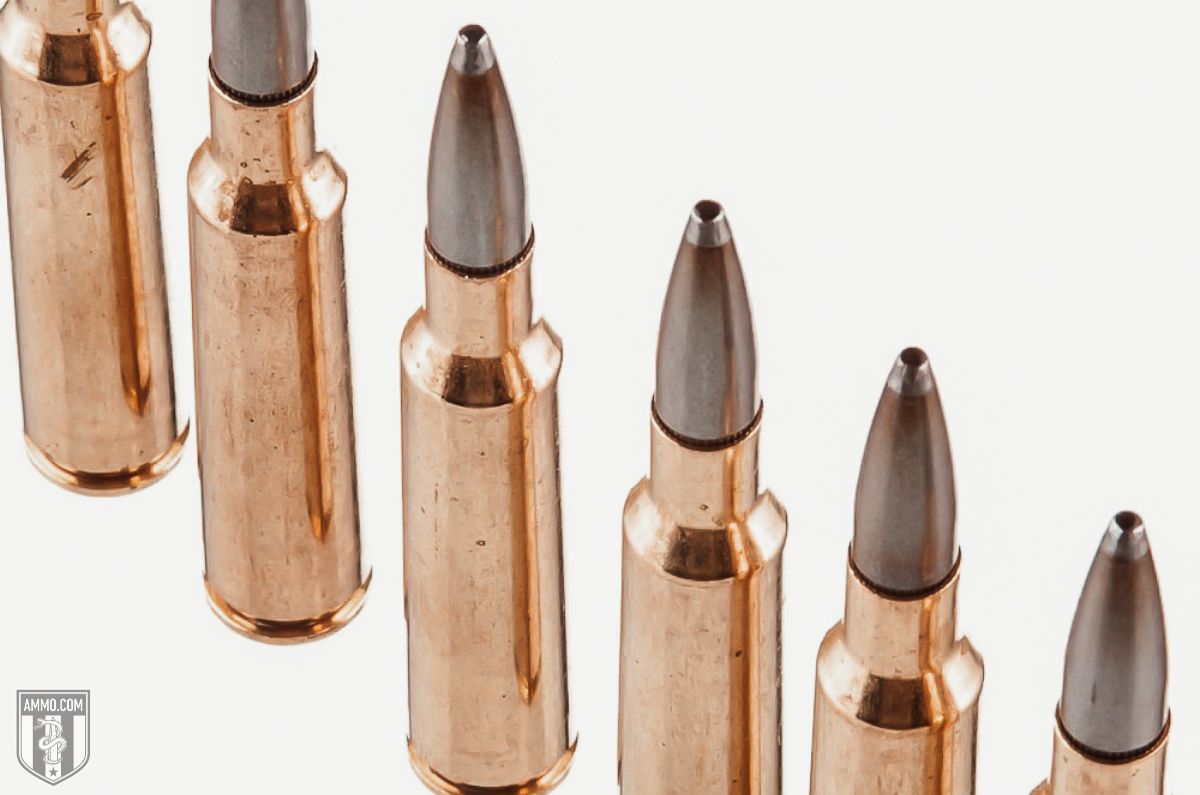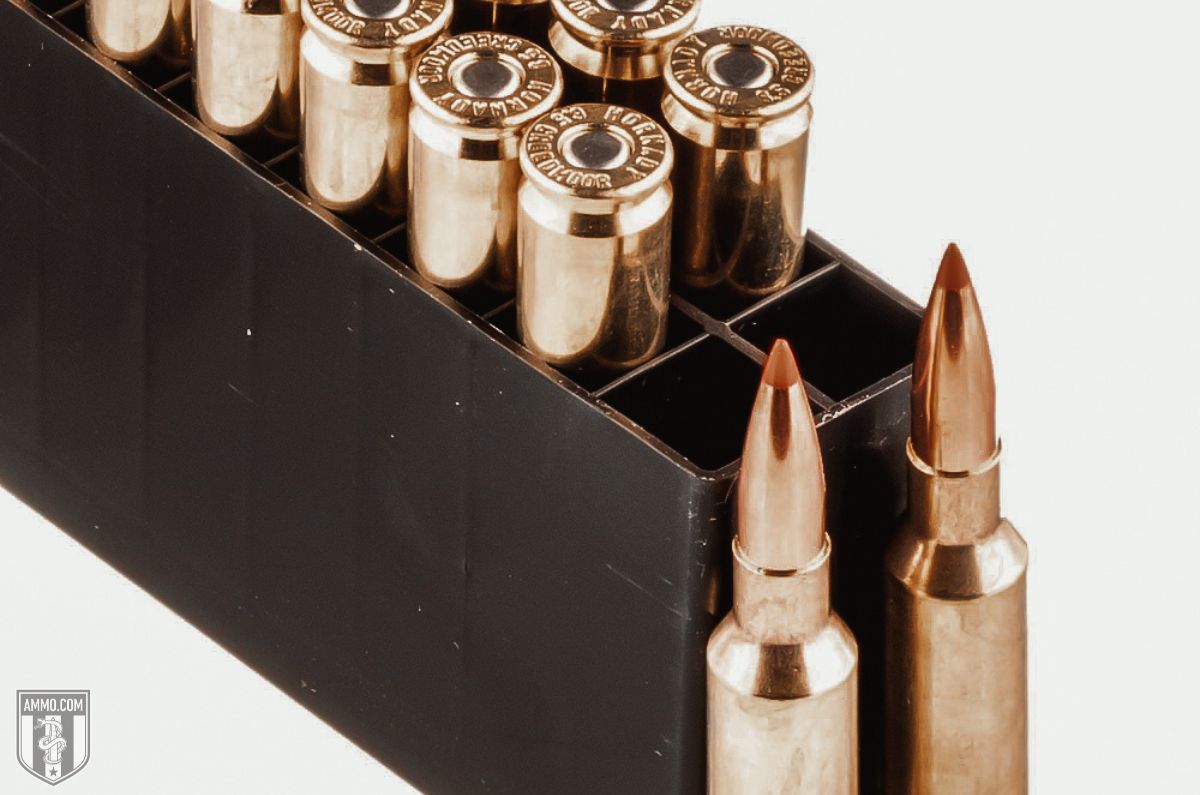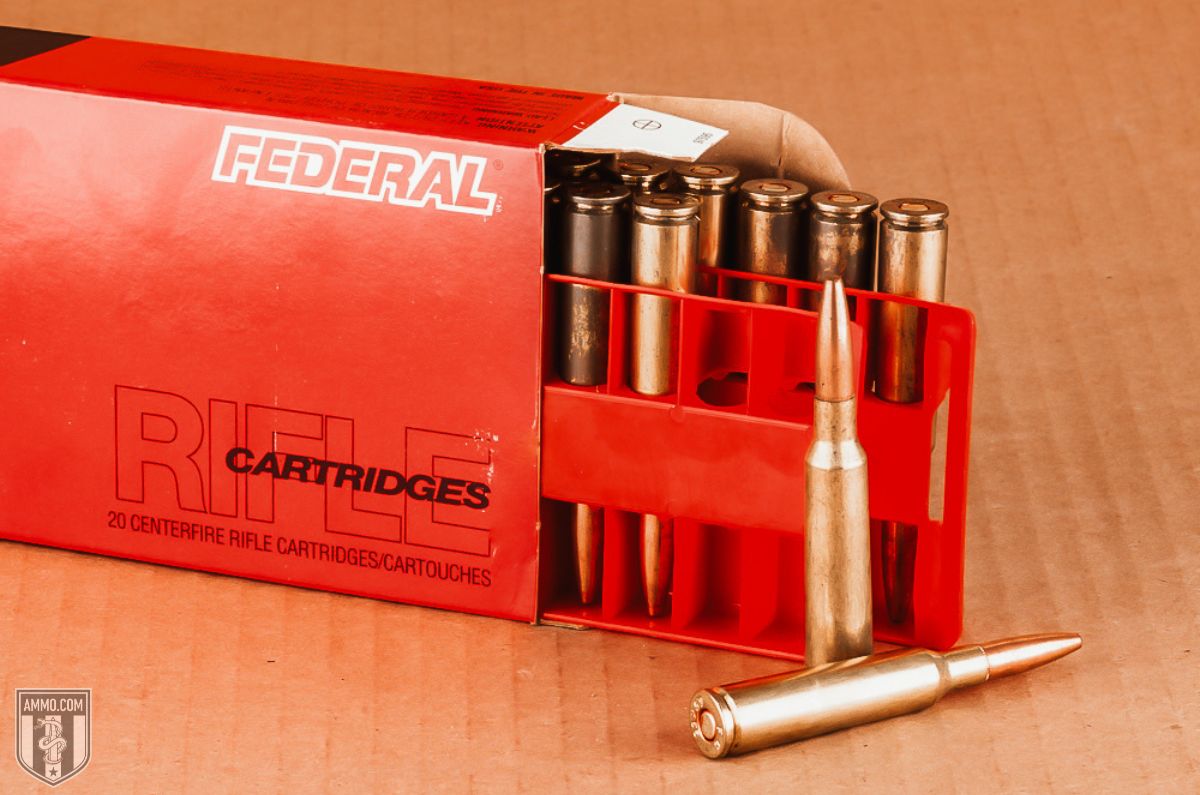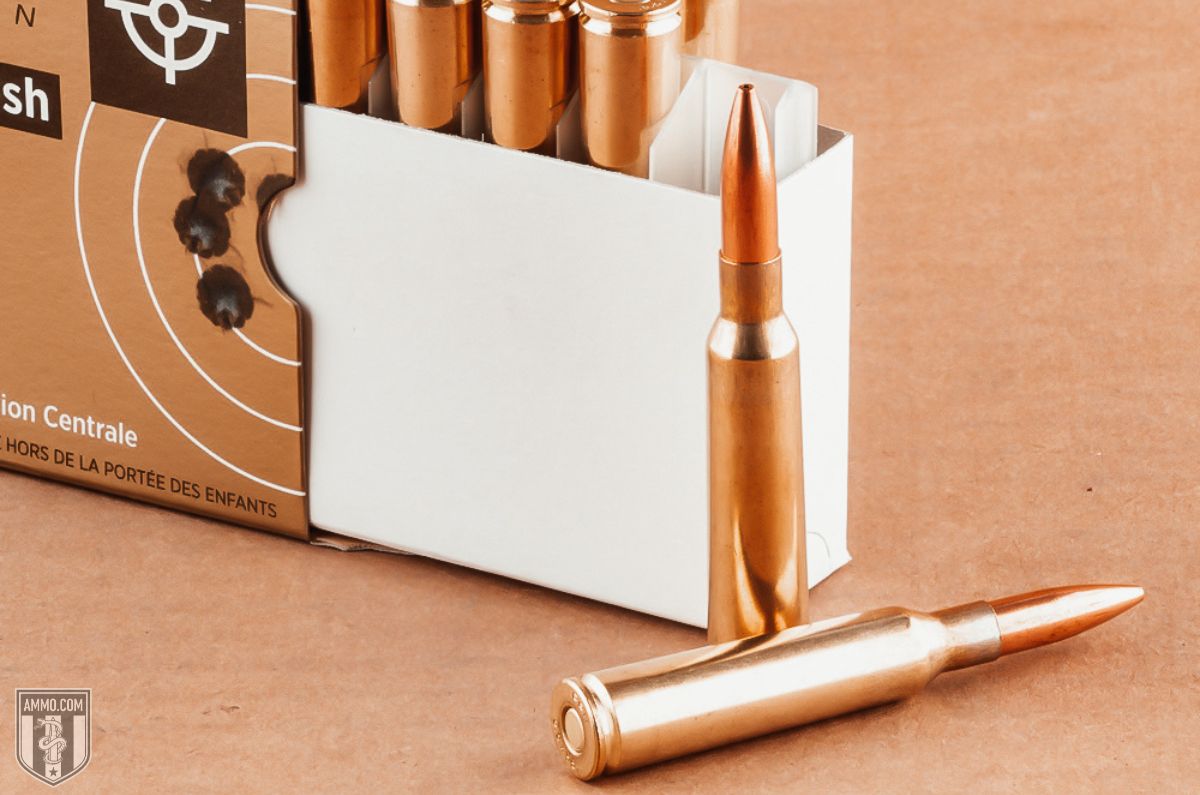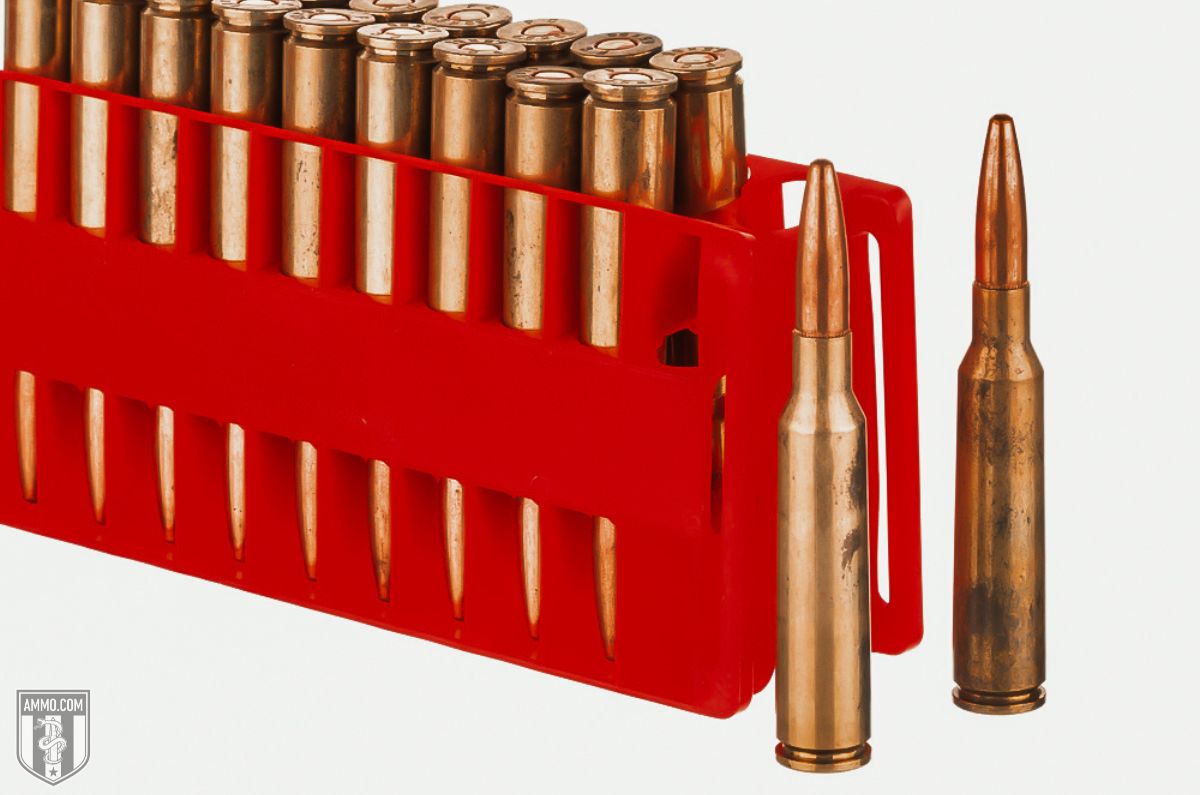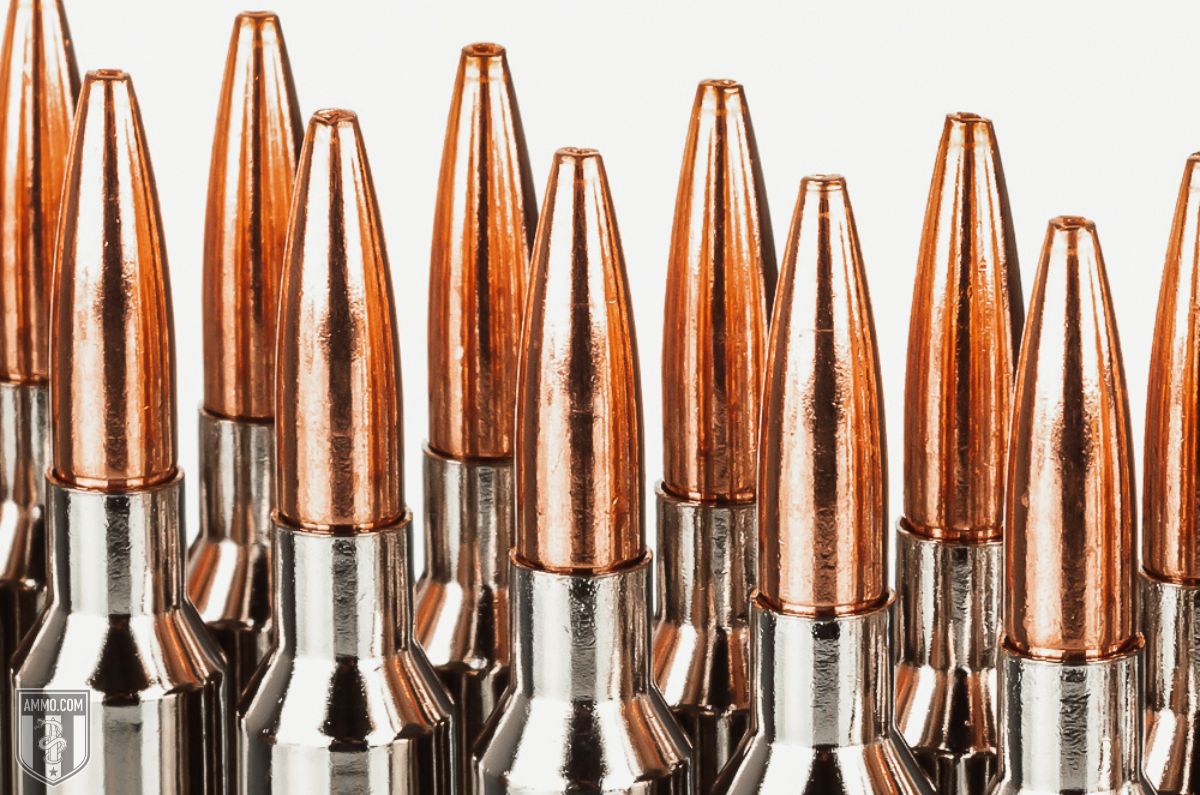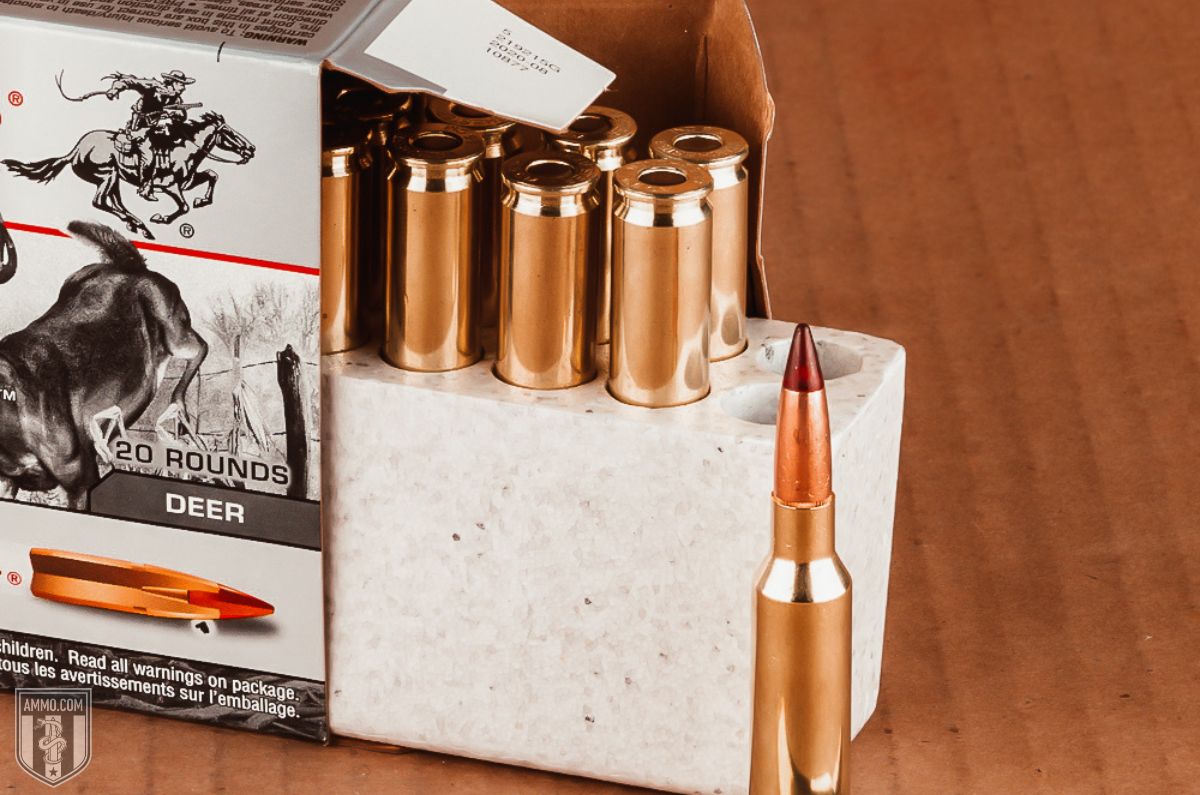6.5x55 vs 6.5 Creedmoor: The 6.5mm New Hotness
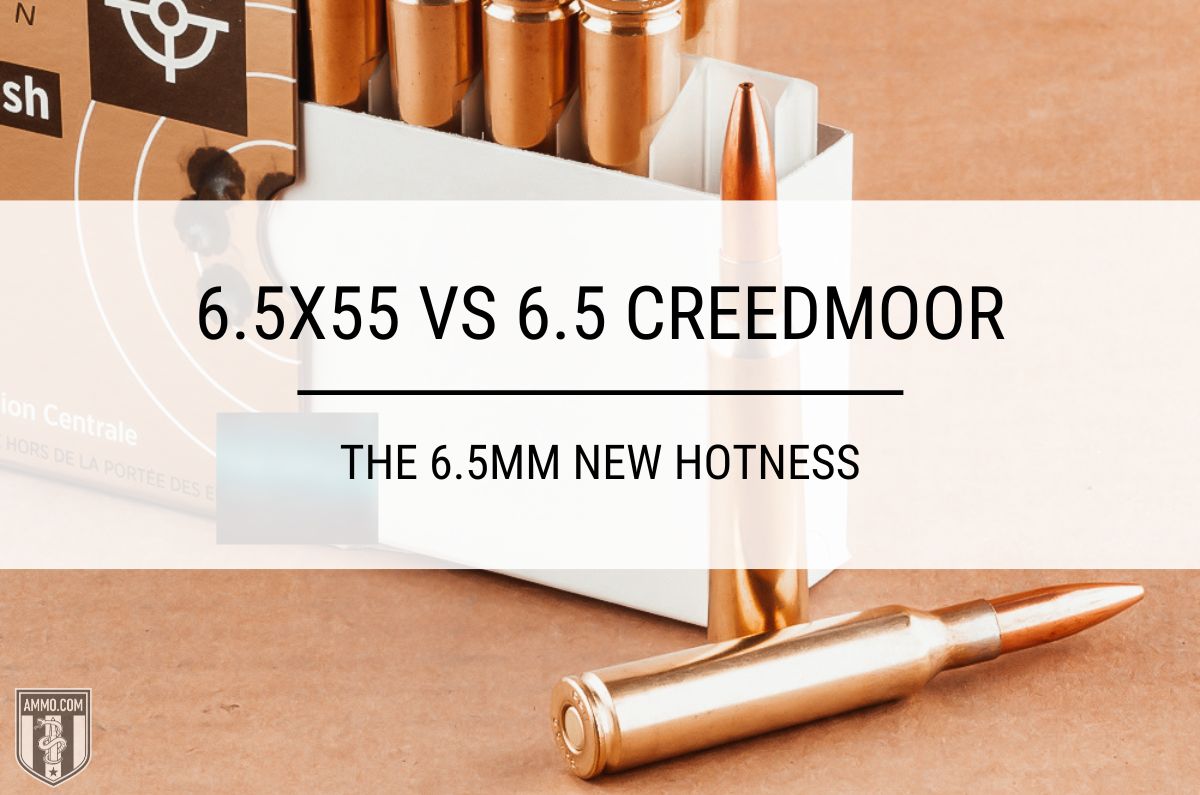
The 6.5 Creedmoor and 6.5x55mm Swedish Mauser are two centerfire rifle cartridges that fire the exact same 6.5mm bullets but were developed over 100 years apart.
This caliber debate can be summed up from one of the more famous lines from the 1997 move “Men in Black” starring Will Smith and Tommy Lee Jones. In the scene, Will Smith says to Tommy Lee Jones, “You know what the difference is between you and me? I make this look good!” Then Smith puts on his Ray-Ban sunglasses and Jones simply grimaces, un-phased by Smith’s bravado.
This scene parallels the 6.5 Swede vs 6.5 Creedmoor caliber debate in a way that only the silver screen can display. Two rounds (Smith and Jones) firing the exact same bullets (Ray-Bans), yet the newer Creedmoor is all the rage while the older Swedish round is nary a blip on many shooters’ radars.
This begs the question if the Creedmoor round really “makes 6.5mm bullets look good”? Or is the old 6.5 Swedish warhorse relatively comparable to the overly confident newcomer?
In this article, we will evaluate the 6.5 Swede vs 6.5 Creedmoor to help you understand the differences between the two and give you a clearer understanding of which cartridge is best for your target shooting and/or big game hunting needs.
What is the difference between the 6.5x55 and the 6.5 Creedmoor?
The main difference between the 6.5x55 and the 6.5 Creedmoor is that the 6.5x55 has a longer overall length and fits into a long action rifle while the 6.5 Creedmoor has a shorter overall length and fits into a short action rifle. Furthermore, the 6.5 Swede has slightly higher case capacity than the 6.5 Creedmoor.
Cartridge Specs
When evaluating centerfire cartridges, it’s a good idea to analyze the cartridge specs to gain more knowledge of each.
Development of the 6.5x55mm Swedish Mauser (6.5 Swede) began in 1891 as part of the Swedish-Norwegian Rifle Commission which did extensive ballistic testing on various bullet diameters. In the end, the 6.5mm bullet was selected for its high ballistic coefficient and flat trajectory.
The 6.5 Swede was designed from scratch and has no parent case. It was eventually adopted for military use in 1894 by the Swedish and Norwegian armed services but used in different rifles. In Norway the round was chambered in the 1894 Krag–Jørgensen rifle while the Model 1896 Swedish Mauser was the selection by Sweden’s armed forces.
The 6.5x55mm Swedish is also know as the 6.5 Swede, 6.5x55 SE, 6.5x55mm SKAN, or simply the 6.5x55.
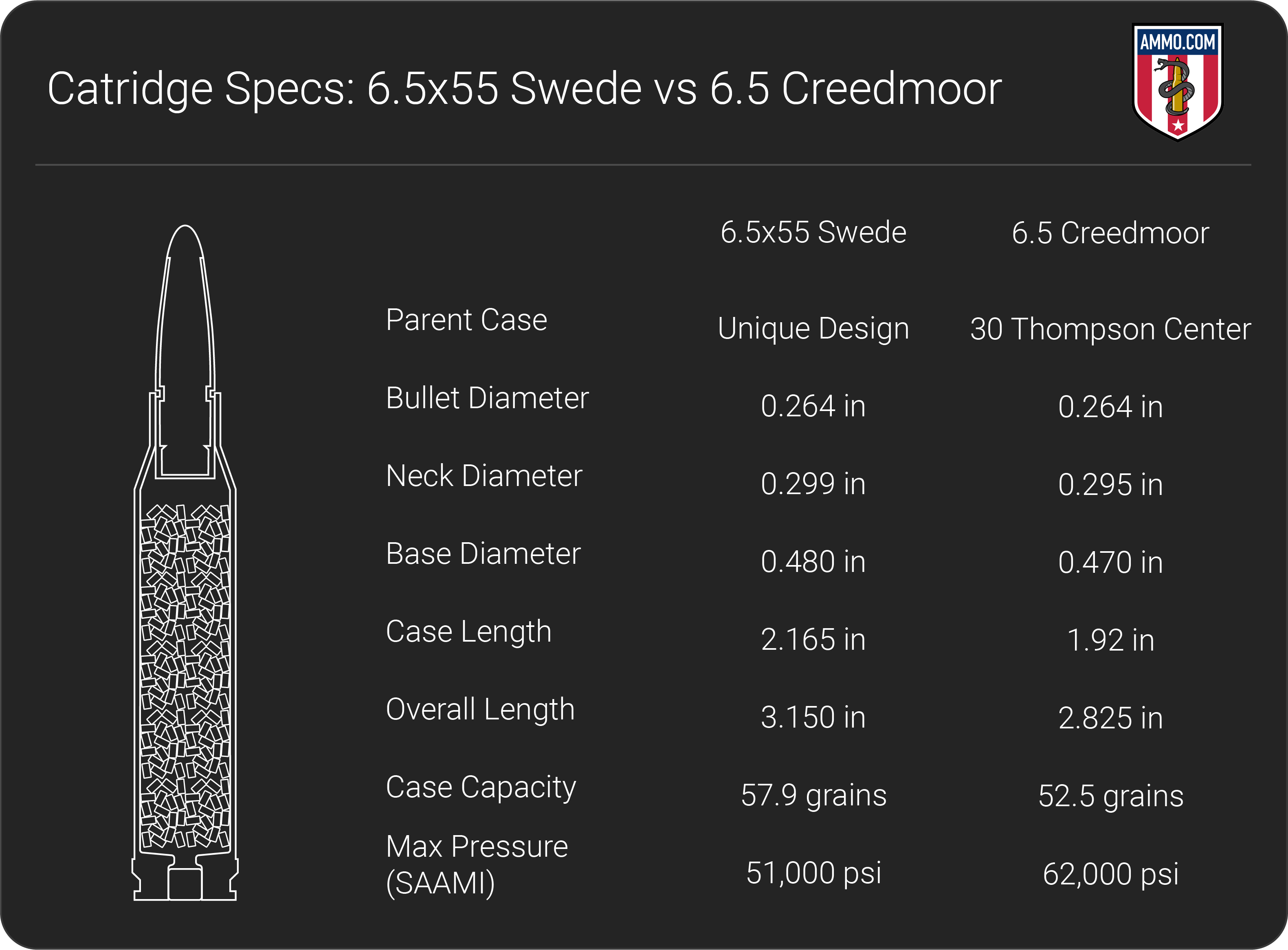
In contrast, the 6.5 Creedmoor was released in 2007 in part due to a gripe session between legendary Service Rifle competitor, Dennis DeMille, and Dave Emary, the senior ballistician for Hornady Ammunition at the time.
The Creedmoor was developed by necking down a 30 Thompson Center case to accept a 6.5mm or 0.264” diameter bullet and was initially developed for long range shooting competitions.
The 6.5 Creedmoor is also called the 6.5 CM, 6.5 Creed, or can be misspelled as “Creedmore”.
One major difference between the 6.5 Swede and the Creedmoor is in their case length. The 6.5 Creedmoor cartridge case measures 1.92” in length, while the Swedish round measures 2.165” long. In terms of overall length, the 6.5 Swede is the longer of the two measuring 3.15” compared to 2.825” for the Creedmoor.
The difference in overall length means that the 6.5 Creedmoor will fit into a short action similar to that of a 308 Winchester, while the 6.5x55 fits into a standard or long action like a 30-06 Springfield.
A short action is often preferred for hunters as the action requires less material, resulting in a lighter rifle. Furthermore, the bolt throw of a short action is less than that of a standard action, meaning follow-up shots from a Creedmoor rifle will typically be slightly faster than those from a 6.5 Swede rifle.
The differences in case length directly relate to case capacity. The 6.5 Swede has a greater case capacity at 57.9 gr compared to 52.5 gr for the 6.5 Creed.
Although the 6.5 Swedish has a higher case capacity, the Creedmoor was designed for modern rifles and can handle higher pressures than the Swede round. The 6.5 Creedmoor chamber is rated to 62,000 psi per SAAMI specs compared to 51,000 psi for the 6.5 Swede.
Although these rounds were developed over a century apart, they both fire the same 6.5mm bullets for their high ballistic coefficients and long-range shooting capabilities. Both rounds can fire bullets between 100 and 150 grains, however 140 grain bullets are by far the most popular factory loads for both calibers.
Recoil
Recoil is an important consideration when purchasing a new rifle as a round with heavy recoil will be more difficult to control and will slow your rate of follow up shots. The potential for flinching is also an issue for cartridges with heavy recoil.
Felt recoil will differ from shooter to shooter and is often dependent on firearm choice, stance, and your chosen factory ammo or handloads. However, free recoil is a more objective measure of how hard a cartridge hits based on firearm weight, muzzle velocity, powder charge, and bullet weight.
For the purposes of this comparison, we will consider Sellier & Bellot ammunition firing 140 grain FMJ bullets for both cartridges. This provides the closest apples-to-apples comparison in terms of recoil.
The Creedmoor factory load has a muzzle velocity of 2,657 fps compared to 2,582 fps for the 6.5 Swede.
The test rifle will be the Winchester Model 70 Featherweight weighting 6.8 lbs, as this rifle has been chambered in both calibers (though the 6.5 Swede version is currently not in production).
Given these parameters, the 6.5 Creedmoor will have a free recoil of 15.3 ft-lbs compared to 14.7 ft-lbs for the 6.5 Swede. Although the 6.5 Swede technically has slightly less free recoil, it is unlikely that even the most recoil sensitive shooter will be able to tell the difference between these two rounds.
In general, the 6.5 Swede and 6.5 Creed will have roughly equivalent recoil.
Muzzle Velocity, Kinetic Energy, and Trajectory
Many long range shooters claim that 6.5 Creedmoor ballistics are superior to virtually any round in existence short of a 50 BMG or cruise missile (just ask them!) However, the seasoned European hunter scoffs at such garish claims as he gestures to a wall of trophies all taken by his trusty 6.5x55.
Let’s see which rifle cartridge has an edge in terms of ballistics.
For this comparison we will select two factory loads for each cartridge. For the 6.5x55 Swedish Mauser we selected the Lapua 155gr soft point (SP) and the Nosler 140 gr Accubond hunting load. For the 6.5 Creedmoor, the Hornady 143 gr ELD-X and Berger 156 gr Elite Hunter cartridges were selected.
There are obviously many more factory loads that we could have selected for this comparison, however we felt that these bullets represent some of the most popular 140 grain options as well as heavier projectiles that could be used for larger game like Scandinavian moose or North American elk.
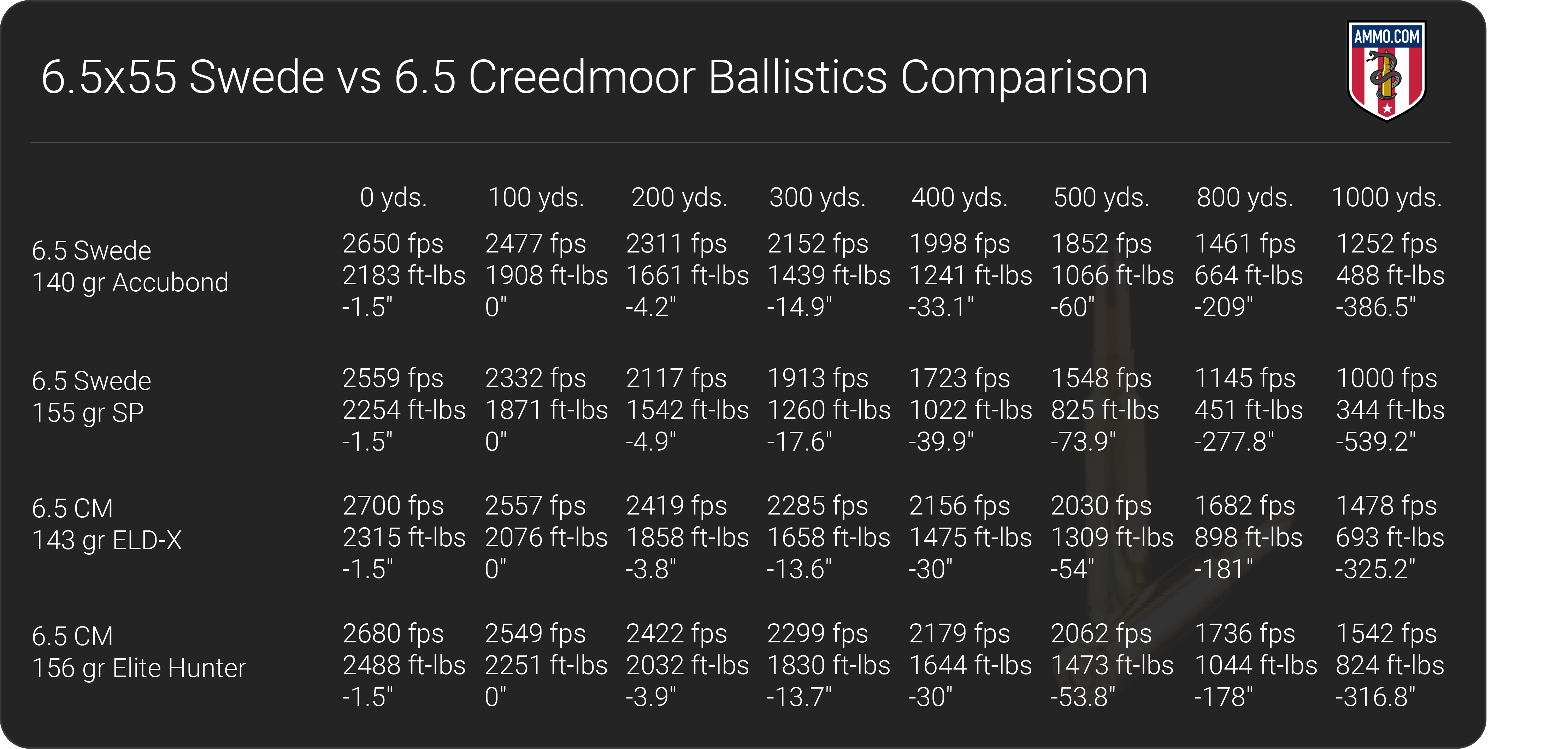
Looking at the 6.5 Swede vs 6.5 Creedmoor ballistic table above, we see some impressive numbers across the board for both rifle cartridges.
In terms of muzzle velocity, the 6.5 Creedmoor rules the roost with the top two slots at 2,700 fps for the 143 gr ELD-X and 2,680 fps for the 156 gr Berger Elite Hunter. However, the 140 gr Accubond for the 6.5 Swede is a mere 30 fps slower than the Elite Hunter, clocking in at 2,650 fps. The 155 gr Lapua soft point had the slowest muzzle velocity at 2,559 fps.
For long distance, the Creedmoor was more efficient at conserving its velocity, as both rounds averaged around 1,500 fps at 1,000 yards. The Accubond was only slightly slower at 1,252 fps while the soft point bullet had gone subsonic and was traveling at 1,000 fps at 1,000 yards.
The story repeats itself when it comes to muzzle energy, as the 6.5 Creedmoor enjoys a slight advantage here as well. The Berger Elite Hunter had the highest muzzle energy at 2,488 ft-lbs while the ELD-X came in second at 2,315 ft-lbs. The two Swede cartridges measured 2,254 ft-lbs for the Lapua soft point while the Accubond came in last at 2,183 ft-lbs of kinetic energy.
At 1,000 yards both Creedmoor rounds were able to remain above 650 ft-lbs of kinetic energy while the Swede rounds fell below 500 ft-lbs.
In terms of short to medium term trajectory, both rounds were relatively equivalent out to 500 yards. The Creedmoor rounds experienced -53.8” and -54” of bullet drop for the 143 gr and 156 gr loads, respectively. The 140 gr Accubond for 6.5 Swede was relatively close to the Creedmoor rounds with -60” of bullet drop at 500 yards but the 155 gr soft point had the highest bullet drop of -73.9”.
At 1,000 yards the differences between the 6.5 Creedmoor and 6.5 Swede were exacerbated considerably with the Creedmoor coming out on top again. The 140 gr Swede factory load had approximately -60" more bullet drop at 1,000 yards than the ELD-X Creedmoor load. The Lapua soft point had the worst bullet drop at -539.2” as the round had dropped below supersonic speeds around 800 yards.
Given this data, what conclusions can we draw?
The one thing that is blatantly obvious is that bullet selection really matters with these rounds. As both of the 6.5mm cartridges can fire the exact same bullets, it’s fair to say that you see similar performance in a 6.5 Swede firing the same bullets as the 6.5 Creedmoor.
Another issue that plagues the 6.5 Swede is its maximum pressure, which is considerably lower than the 6.5 Creedmoor. It’s important to remember that the max pressure for the 6.5 Swede was set using an older Swedish Mauser, which cannot handle higher pressures like modern rifles can. This is one reason why the Creedmoor can produce slightly better ballistics as it can be loaded hotter.
If we only consider factory ammo of similar bullet weights, the 6.5 Creedmoor will come out on top most of the time. However, if you handload for your 6.5x55 you should see similar performance from both 6.5mm cartridges.
Ballistic Coefficient and Sectional Density
Ballistic coefficient (BC) is a measure of how aerodynamic a bullet is and how well it will resist wind drift. Sectional density (SD) is a way to evaluate the penetration ability of a bullet based on its external dimensions, design, and weight.
As both of these 6.5mm cartridges can fire the same bullets, there is will be no difference between them in terms of ballistic coefficient and sectional density.
One of the major benefits of shooting 6.5mm projectiles is that they have an incredibly high ballistic coefficient for their weight. Take for example the 140 grain Berger VLD Hunting bullet with a BC of 0.6 or the Nosler 140 gr RDF with a BC of 0.658.
To put this in perspective, my favorite 0.308” caliber bullet, the Sierra 175 gr Matchking, that we lovingly call the “Dwulet load” on our Ammunition Guides Podcast, only has a BC of 0.505.
In terms of sectional density, the 6.5mm bullet is extremely effective at penetration as it focuses all of its energy into a small cross-sectional area. Most high-end hunting projectiles will have a SD around 0.28 which is more than enough for deer, elk, and moose.
Hunting
Both the 6.5 CM and 6.5x55 make an excellent choice for your next big game hunting rifle.
Shortly after its release in 1894, Scandinavian hunters quickly took a liking to the new 6.5x55 cartridge for its effectiveness on reindeer and moose. It packed enough kinetic energy and stopping power to get the job done on big game and a flat trajectory that every hunter likes.
It should be noted that European moose are smaller than those found in the northern continental United States, Canada, and Alaska. FYR, European moose are typically closer in size to American Elk.
Although the ballistic performance of the 6.5 Creed is like that of its Swedish counterpart, the Creedmoor was not an immediate hunting success. One of the major reasons for this was North America’s devout love affair with the 0.308” diameter bullet, as rounds like the 300 Win Mag and 30-06 Springfield were not easily unseated as the undisputed kings of the woods.
However, as American shooters started warming up to the sub-MOA groups and low free recoil the 6.5 Creedmoor had to offer, they were more open to testing the round on medium sized game like whitetail and pronghorn.
There is a lot of debate among hunters about the effectiveness of the 6.5 Creedmoor for elk.
There’s no debating that the round has the kinetic energy needed to take down an elk (1,500 ft-lbs) within 300-400 yards, depending on your chosen load. However, some hunters feel the 0.264” diameter bullet lacks the penetration ability and higher kinetic energy that a 300 Win Mag, 300 Weatherby Magnum, or 300 PRC can bring to bear.
The main sticking point for 6.5mm cartridge aficionados is the age-old debate of shot placement vs stopping power. If you can slip the bullet between the ribs and straight through both lungs and the heart, there’s little need for a heavy-recoiling 30-caliber.
However, if your shot placement is not perfect and the animal will have to expire via blood loss, a 30-caliber bullet will obviously leave a bigger hole than a 0.264” diameter one.
Without a doubt, practicing with your hunting rifles is the key to success. Being able to put rounds on target where they need to be is the best way to ensure a clean and ethical kill on any big game animal.
In our opinion, both of these 6.5mm cartridges are more than enough for elk within their effective range. Just make proper bullet selection and be able to put rounds on target where they need to go and you should have little problem putting elk in your freezer.
Ammo and Rifle Cost/Availability
The 6.5 Creedmoor outstrips the 6.5x55 in both ammo and rifle availability due to its widespread popularity in North America.
In terms of ammo availability, the 6.5 CM currently holds an approximate 5:1 advantage over the 6.5 Swede. Every major ammo manufacturer like Hornady, Winchester, Federal, Remington, Norma, Berger, and Barnes make some form of 6.5 Creedmoor ammo.
On the other hand, there are only a few 6.5 Swede manufacturers that currently load for the round, Lapua and Sellier & Bellot have the most diverse ammo lines while Federal, Hornady, and Nosler have limited offerings for the cartridge.
As far as price is concerned, inexpensive plinking FMJ ammo can be had for 6.5 Creedmoor at around $1.40/round while premium match-grade or hunting ammo will run around $2-3/round. The Swede is similarly priced with practice ammo going for about $1.30/round while premium hunting loads typically punch holes in your wallet at a rate of $2.50-4/round.
In terms of firearms, there are bolt-action rifles aplenty for the 6.5 Creedmoor. Every manufacturer has some offering in the 6.5 CM as it has become one of the most successful new rounds to hit the market in many years. If you’re into long range target shooting, Ruger and Savage have competition-ready rifles available at a reasonable price point.
In terms of semi-auto capability, the 6.5 Creedmoor is also available in the AR-10 platform, as well as being offered in the Springfield M1A and the FN SCAR 20S.
For the 6.5x55 I hope you like bolt-action rifles, Swedish Mausers in particular, because this will be your main option. The M96 Mauser is the most popular and least expensive firearm for the caliber, but older military surplus rifles are typically not the best options for big game hunting as they are setup for iron sights and not magnified options.
However, there are several European modern rifle companies who have not given up on the 6.5 Swede and have new rifles available. Those companies being Sako, Carl Gustaf Mauser, Steyr, and Tikka.
CZ USA is one of the few North American companies who currently offer a bolt-action rifle in 6.5x55. Many years ago, you could get a Winchester Model 70 chambered in 6.5 Swede but those have been out of production for many years and finding one will be tricky (and expensive).
You can also find several custom rifle makers who still chamber for 6.5x55 but be ready to pay a premium if you go this route.
Reloading
Reloading is one method shooters use to reduce their overall cost per round and increase the consistency and accuracy of their ammo. Furthermore, handloads can be tailored to your rifle to meet your specific shooting needs.
Handloading is really where both rounds shine, as reloaders can routinely achieve sub-MOA groups with proper load development and bullet selection.
The 6.5 Swede offers about a 10% case capacity increase over the 6.5 Creedmoor, which gives it a lot of room for customization. Many handloaders have achieved exceptional results using modern 6.5mm bullets in the 6.5 Swede case, allowing them to have nearly identical ballistic results when compared to the 6.5 Creedmoor.
However, we cannot ignore the fact that these two 6.5mm cartridges are not the only two 6.5’s in town.
Prior to the release of the 6.5 Creedmoor there was the 260 Remington. Sadly, the 260 Rem was a little bit ahead of its time and did not see the same success as the 6.5 Creed. Then of course there is the 6.5x55 Ackley-Improved wildcat that adjusts the shoulder angle of the Swede to increase its case capacity.
However, the two newest hotrod 6.5’s are unquestionably the 26 Nosler and 6.5 PRC. These magnum loads push the ballistic performance of 0.264” diameter bullets to a new level at the cost of reduced barrel life.
To read more about the 26 Nosler and 6.5 PRC, check out this article: 26 Nosler vs 6.5 PRC
However, all these 6.5mm cartridges fire the same bullets, which means they will be plentiful and easy to find. Reloading data can be found for both rounds in newer reloading manuals (remember the 6.5 CM was released in 2007) and there are plenty of powders to choose from for both cartridges.
Sourcing brass will be easier for the Creedmoor due to its popularity, but 6.5x55 brass is not difficult to find on the secondary market if you cannot find factory ammo.
Reloading is one way to ensure that you always have ammo to practice with, and it allows you to really achieve the true potential of both the 6.5 Creedmoor and 6.5 Swede.
Final Shots: 6.5 Creedmoor vs 6.5x55
The 6.5 Creedmoor and 6.5x55mm Swedish Mauser are two rifle cartridges that take full advantage of the extremely aerodynamic 0.264” diameter bullet. They offer exceptional ballistics with low recoil that is ideal for long-range shooting and hunting.
The 6.5 Swede is one of those rifle cartridges that refuses to fade away. It is beloved by European hunters for its efficacy on big game as well as long range capability for benchrest target shooting.
The 6.5 Creedmoor was the breakthrough round of the 2000’s that brought the efficacy of the 6.5mm bullet to the forefront for American shooters. It has quickly become one of top 5 rifle cartridges sold in North America and is only gaining in popularity with every passing year.
Although its performance is slightly eclipsed by hotrod rounds like the 6.5 PRC or 26 Nosler, the 6.5 Creedmoor provides MOA accuracy at 1,000 yards while chambered in a short action, which is a feat that few rounds can lay claim to.
Although the 6.5 Swede can be optimized through reloading, our choice is the 6.5 Creedmoor as it has considerably higher ammo availability and finding a new hunting rifle is a relatively simple task.
This is not to say that the Swedish round is obsolete, quite the opposite as it fells countless reindeer and European moose every year. However, the Creedmoor offers slightly improved ballistic performance with factory ammo that we cannot ignore.
No matter which cartridge you choose, make sure you stock up on ammunition here at Ammo.com and I’ll see you on the range…And don’t forget your Ray-Bans!
Ammo Comparisons
- .308 vs 5.56
- 6.5 Creedmoor vs .308
- .300 Blackout vs .308
- .300 Win Mag vs .308
- .243 vs .308
- .308 vs .30-06
- 7mm-08 vs .308
- .270 vs .308
- 7.62x39 vs .308
- .223 vs .308
- .338 Lapua vs .308
- .380 ACP vs 9mm
- .223 vs 5.56
- .300 Blackout vs 5.56
- 9mm vs 45 ACP
- 9mm vs 40 S&W
- .357 SIG vs 9mm
- 10mm vs 9mm
- 9mm vs 9mm Luger
- .243 vs .270
- .300 Win Mag vs .30-06
- .270 vs .30-06
- .40 vs .45
- 38 Special vs 357
- 9mm vs 40 vs 45
- 5.56 vs 7.62x39
- 338 Lapua vs .30-06
- .30-30 vs .30-06
- 300 PRC vs 338 Lapua
- .30-06 vs 7mm
- 300 Win Mag vs 338 Lapua
- 300 PRC vs 300 Win Mag
- 300 WSM vs 300 Win Mag
- 338 Win Mag vs 338 Lapua
- 12 Gauge vs 20 Gauge
- 10mm vs 357 Mag
- .30-30 vs 7.62x39
- 224 Valkyrie vs 22-250
- 17 HMR vs 22 Mag
- 7.62x39 vs .300 Blackout
- 45 ACP vs 45 Auto
- 45-70 vs 30-30
- 300 Blackout vs 223
- 357 Magnum vs 9mm
- 350 Legend vs 300 Blackout
- 224 Valkyrie vs 223
- 45 ACP vs 38 Super
- 6.5 Grendel vs .308
- 17 HMR vs 22 LR
- 10 Gauge vs 12 Gauge
- 22-250 vs 223
- 45 Colt vs 45 ACP
- 350 Legend vs 30-30
- 5.7x28 vs 223
- 5.7 vs 9mm
- 5.56 vs 5.7
- 22 vs 9mm
- Buckshot vs Birdshot
- 450 Bushmaster vs 308
- 450 Bushmaster vs 223
- Buckshot vs Slug
- 6.5 Grendel vs 5.56 vs 223
- 6mm ARC vs 6.5 Grendel
- 44 vs 45
- 458 SOCOM vs 5.56
- 357 vs 44
- 32 ACP vs 380
- 300 Win Mag vs 338 Win Mag vs 338 Lapua Mag
- 450 Bushmaster vs 458 SOCOM vs 50 Beowulf
- 6mm Creedmoor vs 6.5 Creedmoor
- TMJ vs FMJ
- 44 Special Vs 44 Magnum
- 45 90 vs 45 70
- 6.8 Western vs 6.8 SPC
- 50 Beowulf vs 50 BMG
- 26 Nosler vs 6.5 PRC
- 28 Gauge vs 410
- 6.8 SPC vs 5.56
- 6.8 SPC vs 6.5 Grendel
- 6.8 Western vs 7mm Rem Mag vs .28 Nosler
- 6.8 Western vs 6.5 Creedmoor
- 22 Hornet vs 223
- 6.8 Western vs 6.5 PRC
- .410 vs 12 Gauge
- .410 vs 20 Gauge
- 22 LR vs 22 Mag
- 6mm ARC vs 243
- 7mm-08 vs 270
- 243 vs 6.5 Creedmoor
- Nickel vs Brass Casing
- 204 Ruger vs 223
- 50 Beowulf vs 5.56
- 260 Remington vs 6.5 Creedmoor
- 6mm Remington vs 243
- 28 Nosler vs 300 PRC
- 50 Beowulf vs 50 AE
- 22 Nosler vs 22-250
- 450 Marlin vs 45-70
- 300 Win Mag vs 300 Norma
- 458 SOCOM vs 300 Blackout
- 38-55 vs 45-70
- 22 Hornet vs 22 LR
- 300 Norma vs 338 Lapua
- 338 Lapua vs 50 BMG
- 28 Nosler vs 300 Win Mag
- 28 Nosler vs 6.5 Creedmoor
- 204 vs 22-250
- 458 SOCOM vs 45 70
- 44 40 vs 45 70
- 6.8 SPC vs 6.5 Creedmoor
- 450 Bushmaster vs 30-06
- 7mm Rem Mag vs 300 Win Mag
- 30 Carbine vs 223
- 25-06 vs 30-06
- 26 Nosler vs 28 Nosler
- 16ga vs 12ga
- 30 06 vs 7.62 x54R
- 9mm Makarov vs 9mm Luger
- 350 Legend vs 223
- 30 Carbine vs 5.56
- 6.5x55 vs 6.5 Creedmoor
- 6.5 Creedmoor vs 270 vs 25-06
- M193 vs M855
- 450 Bushmaster vs 458 SOCOM
- 6.5 Grendel vs 6.5 Creedmoor
- 350 Legend vs 5.56
- .277 Fury vs 6.8 SPC
- 277 Fury vs 300 Win Mag
- 10mm vs .45 ACP
- 277 Fury vs 223
- 6.8 SPC vs 300 Blackout
- 6.5 PRC vs 6.5 Creedmoor
- 277 Fury vs 308
- 277 Fury vs 6.5 Creedmoor
- 350 Legend vs 450 Bushmaster
- 277 Fury Vs 5.56 NATO
- 10mm vs 40S&W
- 32 ACP vs 9mm
- 32 Special vs 9mm
- 8.6 Blackout vs 300 Blackout
- 30 Super Carry vs. 9mm
- 5.56 vs 9mm
- .50 Action Express vs 9mm
- 7.62x25 vs. 9mm
- 10mm vs 44 Magnum
- 300 Blackout vs 300 Win Mag
- 6.5 Grendel vs 300 Blackout
- 460 Rowland vs 10mm
- 300 RUM vs 300 PRC
- 300 Norma vs 300 PRC
- 45 GAP vs 45 ACP
- 7mm PRC vs 300 Win Mag
- 300 PRC vs 6.5 Creedmoor
- 300 PRC vs 308
- 357 SIG vs 357 Mag
- 7.62x39 vs 7.62x51
- 243 Win vs 223 Rem
- 30 Nosler vs 300 PRC
- 6.5 Creedmoor vs. 30-06 Springfield
- 450 S&W vs. 44 Magnum
- 6.5 Creedmoor vs. 300 Win Mag
- 454 Cassull vs. 45-70 Govt
- 454 Cassull vs. 44 Mag
- 7.62x54r vs. 308 Winchester
- 22 ARC vs. 223 Rem
- Subsonic vs. Supersonic Ammo
